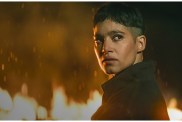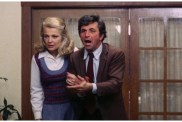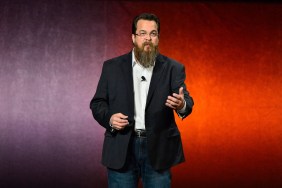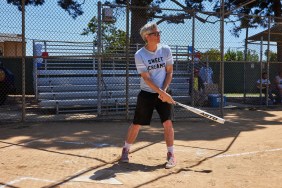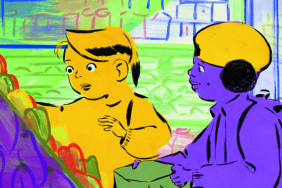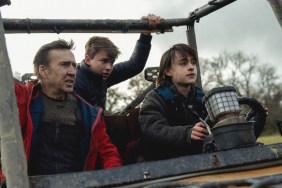Q: Talk a little bit about getting back on set. What was your reaction to stepping back into this world the first day?
Orlando Bloom: It was sheer joy. It was also a little bit of, “Oh, my word. This is ten years later. I’m ten years older and how’s this all going to work?” I quite literally was like, “Can I just try on my old costume just for the posterity of it all?” It was amazing that Pete [Jackson template=’galleryview’]–> was back at the helm of this movie and it was amazing that I got a call to say, “We would love you to be a part of the film.” I was just full of excitement. I was obviously like, “Ooh! This is going to be interesting to make the transition as an Elf being ten years older as myself, as an actor, going in to playing a character that would be younger. But as Elves are kind of ageless anyway, we’ve managed to bridge the gap.
Q: Is there much difference between Legolas in “The Hobbit,” versus Legolas in “The Lord of the Rings” as far as his personality goes?
Bloom: No. Not masses. Essentially, the Woodland Realm Elves, which is where Legolas is from, my father being Thranduil, the king of those Elves, are a particular type of Elf as described by Tolkien to be… I’m not going to quote him correctly, but they are different from the Lothlorien and the Rivendell elves. They’re more militant if you like. Legolas in “Lord of the Rings” was sent as a bridge from his people into the world of Dwarves and humans and wizards and everything else. This is an introduction into the Woodland Realm Elves. Obviously we meet my father, Thranduil, who is a very powerful and strong character, who is very particular in his vision of who the Elves are. Who the Woodland Elves are, specifically. They are kind of, like I said, a militant group, the Woodland Realm Elves. I think that the opportunity that Pete and Philippa and Fran and the writers and Pete saw was to create. I think there was a desire for Legolas to come back. They felt that the fans would appreciate seeing Legolas in the Woodland Realm and there was an opportunity to create a father-son, a prince versus king dynamic, that would be interesting and serve the story.
Q: Knowing how successful “The Lord of the Rings” trilogy was and the fact that Legolas isn’t actually in “The Hobbit,” was there ever any hesitation on your part about taking a role in this film?
Bloom: Not after I had spoken to Peter. Their ideas, which I have explained, were made clear to me about how it could be made seamless and effective. Not after I’d had that conversation. It was definitely something that anyone would think. There’s a big love for these books and these films and these stories. I think in the hands of Peter, the fans, I would hope, would rest assured that he will deliver a movie that will both entertain and enjoy and will be in keeping with Tolkien’s vision of the stories. They never stray at all from Tolkien’s vision of what the world is and, for me, it was exciting to think of returning to Middle-earth and to be a part of something. This is Pete in his element, doing what he does best. It was just very exciting.
Q: You guys pushed the boundaries of technology on the first three films. On this one you’re dealing with forty-eight frames a second, the Red EPIC 3D and the slave motion cam. Can you talk about working with all this cutting edge filmmaking technology?
Bloom: I’ve never been a great one for technology. What I can tell you is that Pete is always going to push the boundaries, especially in a movie like this. The way that Pete explained it to me at the beginning of the movie, it slightly went over my head. At the same time, though, it was very simple. It was that shooting at 48 frames a second in 3D was going to make the experience for a movie-going audience much more pleasurable and natural and seamless. It would make it all very much more real. In terms of an actor experiencing the slave Mo-cap aspect of it is interesting. It’s very interesting. It is definitely new technology that can sometimes be challenging. Once you grasp what is required, from what I’ve seen, it looks amazing. It looks incredible. A lot of what we did on “Lord of the Rings,” what Pete did, it was just perspectives and shifting things. It was very rudimentary in comparison to what’s being done today. In answer to your question, I’m as excited as you are, and I hope audiences will be to see how that all gels. I know that it’s something that Pete and his team will be doing, working extensively on to make it just the best experience that you can possibly have in the theater.
Q: Could you describe a little bit about what goes into acting for the slave cam, just in your words?
Bloom: Essentially, you have something very rudimentary. There’s a green screen on one side of the studio with the Dwarves. If I’m doing a scene with the Dwarves — who would be probably at my waist height — there’s a slave cam on one side where they’re acting and then I’d be on a set, or vice-versa. They could be on the set and I could be on the green screen slave stage. The movements are mapped out and we will have done some kind of work leading up to that in rehearsal with doubles and with the actors. Then it all gets meshed into a computer and magically presented to you as two perfect worlds. I can’t explain it any better than that, I’m so sorry. It’s not my forte.
Q: Does the playback when they put the two together help you though?
Bloom: Yes. Absolutely, yeah for sure. At sometimes it’s necessary to see and sometimes it isn’t. Because you don’t want to walk on top of somebody. Yeah.
Q: Do you have to stay very conscious of every little movement you do? Does it ever become distracting on a technical acting level?
Bloom: I have to say it isn’t. Not at all. These cameras that they’re using – we’re doing hand held shots. We’re doing over the shoulder shots. There’s motion camera shots. When I did “The Three Musketeers,” there were ginormous cameras to move around, but I think that was on film. This is digital and these Red Cameras, they’re still somewhat bigger than the old film cameras, but they’re managing to use them. They’re small enough to be able to do everything that you would do with any other camera and you don’t act for a 3D camera. You act for a camera and the director creates shots that make that work. It doesn’t change the process for me as an actor working in 3D.
Q: Because we know that Legolas and Gimli form this bond in “Lord of the Rings,” does your dislike of Dwarves appear in this? Is it sort of backwards acting to strengthen that bond by seeing how different he is earlier on?
Bloom: Yes. This is a precursor and certainly you will understand where the rift has come from. Absolutely… I’m taking really what has been presented in terms of the script and the story. If it rings true to me and for the character, which it has done — because as I said, the writers and Pete are very conscious of that — then I don’t really have to over think it because it was their intention to lay the groundwork that would play into a movie like “Lord of the Rings.”

Q: You have, in “The Lord of the Rings” movies, some “holy s–t” moments. I’m curious if you have anything like that in particular in this one.
Bloom: Yes! One of the great things about the character is the “holy s–t” moments, so I would hope that the audience will certainly appreciate a couple of those “holy s–t” moments. Pete’s very conscious and we’ve been working on things for that purpose. Yeah, there’s some cool beats. There’s some cool beats. We did one the other day.
Q: Did you have to re-train much for this? Is it all like getting on an old bike, and it just comes back?
Bloom: No, I did. I came in early and it was a pleasurable thing to do. It’s a really great character to be in the middle of. I got back in to some of the Elven movement things and the physicality of the character, which is very different, ten years on. Your human body and how your human body behaves. It was useful for me to go back and look at the Elven dialect and movement and to go back and do the archery and get my eye back in for all of those things. It was a really great, enjoyable part of embracing the character again for this.
Q: Do any of the other actors, the newer actors in the cast, come to you for insight or advice, being that you’re one of the veterans of these films?
Bloom: To be honest, we’ve got some formidable actors on this movie, all of whom have actually been here a lot longer than I have in truth. They were shooting the Dwarves and all of those things. That world was shooting a lot longer, so they were all much more comfortable with being on set and stuff. There’s always that period before you ever go on to a movie where you just want to get one in the can. Once you got one in the can, then you’re like, “Okay, I’m good to go.” So I wouldn’t say that’s been the case, and it’s also very different.
Q: Almost the exact opposite of that question, but have you had any scenes with some of the original cast members from the original trilogy?
Bloom: Not as of yet. But I believe there are plans afoot, so yeah. But not as yet, no.
Q: Any Dwarf tossing like in the last trilogy?
Bloom: There’s some fun other Dwarf moments coming up. I don’t want to give too much away, but there will be some fun interaction. It is different though, because, as it was pointed out earlier, the relationship [is different template=’galleryview’]–>. The friendship that grew out of the relationship between Legolas and Gimli grew over a three movie period. I’m more seeing the Dwarves as I would have seen them prior to going in to the Council of Elrond, which is full of disdain for what I, fundamentally as an Elf, believe their purpose is in life. There’s not the same sort of thing, but there’s definitely some jibes and moments that are good.
Q: An even sillier question, but have you seen “The Avengers” yet and did you like the Legolas shout out in there?
Bloom: Oh, man, I have not seen it! I was going to see it last night, funnily enough. I didn’t get to see it. There’s a Legolas shout out? That’s amazing. I really want to see it. I hear it’s very, very good. It’s amazing. Oh, that’s cool, really? That’s awesome. Good.
Q: Are you getting script pages the night before that are changing, or is it pretty much been sticking to what you originally read.
Bloom: Can I answer that question? Yes. Pages the night before is a very common occurrence.
Q: Was it that way on the original films?
Bloom: The way that Pete, Fran and Philippa work is specific to them, and yes, there were often script revisions right up until the last minute. It’s a huge undertaking, a movie like “The Lord of the Rings,” but also this movie. It’s a huge undertaking. I think that things are always in flux, but we started with a script that has been evolving, if you like, and improving as we go. That’s their goal and that’s why, when there are script revisions, there can be script revisions right up before, but it’s essentially the tenant of the scene is the same. It’s just there are moments that are heightened or created and stuff, but yeah, there’s definitely a lot of movement within the script to keep moving it forward. I think it works for them and it works for the story and it’s a huge undertaking, do you know what I mean? I know that they take it very seriously. And their desire for it to be as good as it can be is what leads to there being revisions that continue on. That’s the way I see it, and I think everyone else does, too.
Q: Can you talk about the dynamic a bit between your character and his father, and how much of that do we actually get to see?
Bloom: I can, somewhat reluctantly, because I think it’s more interesting for people to see it. When I say to you there is a certain rivalry – a prince versus a king, a father versus a son. There’s definitely a bit of father-son rivalry, prince-king rivalry that forwards the story. I don’t really want to elaborate on it more than that, but it makes for a more interesting dynamic. Thranduil being the king of the Woodland Realm and, as I’ve said, those Elves being more of a militant group of Elves. Knowing that Legolas goes on to be a bridge, like an architect for peace between the Elves and the rest of the world, you might be able to guess there might be a little bit of me trying to understand more of what the plight of the rest of the world is and therefore somewhat coming up against odds with my father. Does that help?
Q: Overall, how would you compare your on-set experience on “The Hobbit” so far with that on “The Lord of the Rings”?
Bloom: The experience of making the movie is completely different. It could never be the same, because there was no expectation. That was a unique thing. On this, obviously, there is a heap of expectation. Actually, the way that the movie is being filmed and shot, it’s really very similar to what the experience was on “The Lord of the Rings,” outside of the key cast and stuff. There’s a sort of creative chaos that breeds, I hope something really special that we saw on “Lord of the Rings.” There’s something about the way that the chaos that is created to make the movies that can lead, and we’ve seen it with “Rings,” and we hope to see it again. Something quite special and unique. It’s unlike any other movie experience for sure. The way that it works, but I think it plays out very well to the advantage of the film and hopefully the audiences when they get to enjoy it.
